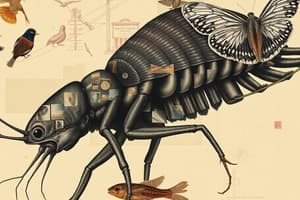Podcast
Questions and Answers
Which of the following characteristics are typical of invertebrates?
Which of the following characteristics are typical of invertebrates?
- Many have hydrostatic or exoskeletons (correct)
- Exclusively large size like giant squids
- Presence of a backbone
- Uniform reproductive strategies
Which classification method is NOT used for invertebrates?
Which classification method is NOT used for invertebrates?
- By body symmetry
- By body cavity presence
- By feeding strategy
- By metabolic rates (correct)
Which of the following is NOT a major taxonomic group of invertebrates?
Which of the following is NOT a major taxonomic group of invertebrates?
- Amphibia (correct)
- Annelida
- Cnidaria
- Protozoa
What is a common characteristic of protists?
What is a common characteristic of protists?
Which of the following correctly describes the symmetry types used in invertebrate classification?
Which of the following correctly describes the symmetry types used in invertebrate classification?
Flashcards are hidden until you start studying
Study Notes
Characteristics of Invertebrates
- Invertebrates are defined by the absence of a backbone.
- They include a wide array of organisms like protozoans, cnidarians, and annelids.
- Size varies from microscopic to large, exemplified by the giant squid.
- Many invertebrates possess either exoskeletons or hydrostatic skeletons for support.
- Body structures are often segmented, allowing for greater complexity.
- Their reproductive strategies show considerable diversity.
Classification Methods for Invertebrates
- Classification can be based on body plans, distinguishing between radial and bilateral symmetry.
- Presence or absence of a body cavity is another criterion: acoelomates (none), pseudocoelomates (false cavity), and coelomates (true cavity).
- Developmental patterns further classify invertebrates into protostomes and deuterostomes.
- Habitats are varied—marine, freshwater, or terrestrial—impacting the specific adaptations of different groups.
- Feeding strategies categorize invertebrates as filter feeders, predators, parasites, and others.
Major Phyla of Invertebrates
- Key groups include:
- Protozoa: A collection of single-celled organisms, not formally recognized as a phylum.
- Cnidaria: Organisms like jellyfish and corals, primarily known for their stinging cells.
- Ctenophora: Often referred to as comb jellies, distinguished by their unique cilia.
- Annelida: Segmented worms that exhibit a wide range of ecological roles.
- This list is not exhaustive but highlights significant invertebrate phyla.
General Characteristics of Protists
- Protists are predominantly unicellular eukaryotes lacking collagen or chitin cell walls.
- They are generally non-photosynthetic, especially in the context of protozoa.
- Protists thrive in moist environments, essential for their survival and reproduction.
- Many exhibit symbiotic relationships with other organisms—be it mutualistic, commensal, or parasitic.
- Typically, protists are small in size but display significant diversity in form and function.
Studying That Suits You
Use AI to generate personalized quizzes and flashcards to suit your learning preferences.




